 Last additions - Nagahama 長浜市 Last additions - Nagahama 長浜市 |
|
|
|

Chikubushima island is officially included in the Sengoku Expo. Accessible by boat from Nagahama Port.May 14, 2012
|
|

Nagahama PavilionMay 14, 2012
|
|
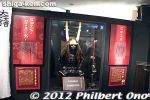
Nagahama PavilionMay 14, 2012
|
|

The Nagahama Pavilion includes a few exhibits, including kimono.May 14, 2012
|
|

The Nagahama Pavilion shows the history of NHK Taiga Drama series over the last 50 years. Almost the same as last year's Go and Azai Sisters Expo.May 14, 2012
|
|

May 14, 2012
|
|

Across from the Nagahama Hikiyama Museum is the Nagahama Pavilion. In 2011 for the Go and Azai Sisters Expo paviion, this was the Nagahama Kurokabe Rekishi Drama 50-saku-kan (長浜黒壁・歴史ドラマ50作館).May 14, 2012
|
|
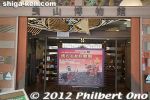
Hikiyama Festival Museum.May 14, 2012
|
|
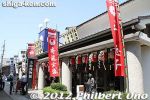
Hikiyama Festival Museum.May 14, 2012
|
|
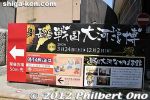
Way to the Nagahama Pavilion.May 14, 2012
|
|

A hime princess posing in the shopping arcade in Nagahama, Shiga.May 14, 2012
|
|

In front of Nagahama Station.May 14, 2012
|
|

When you get out of Nagahama Station, you see this sign/map showing the way to the Nagahama Pavilion, a short walk.May 14, 2012
|
|
|

May 14, 2012
|
|
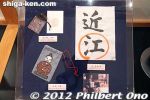
May 14, 2012
|
|
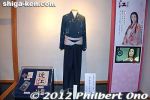
May 14, 2012
|
|

May 14, 2012
|
|
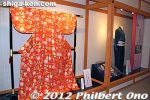
These were displayed at last year's Azai Sisters Expo.May 14, 2012
|
|
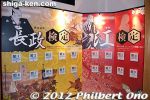
Go and Azai Sisters Memorial HallMay 14, 2012
|
|

May 14, 2012
|
|

May 14, 2012
|
|

Go and Azai Sisters Memorial HallMay 14, 2012
|
|

Go and Azai Sisters Memorial HallMay 14, 2012
|
|

Go and Azai Sisters Memorial HallMay 14, 2012
|
|

The tourist gift shop has a Go and Azai Sisters Memorial Hall. Good to visit if you missed last year's expo.May 14, 2012
|
|

Tourist gift shop.May 14, 2012
|
|
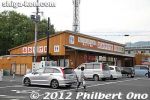
Tourist gift shop.May 14, 2012
|
|
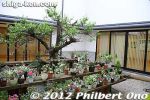
May 14, 2012
|
|

Inside the gift and produce shop. This was where they displayed kimono in 2011. Now a gallery.May 14, 2012
|
|

May 14, 2012
|
|

Inside the gift and produce shop.May 14, 2012
|
|

During the Azai Sisters Expo in 2011, this was the Azai–Go no Drama-kan (浅井・江のドラマ館). Now it's a gift and produce shop.May 14, 2012
|
|
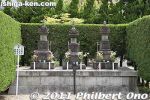
Graves of the Azai clan at May 14, 2012
|
|
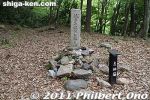
Where Azai Nagamasa committed suicide at Odani Castle when it was under attack by Hideyoshi.May 14, 2012
|
|
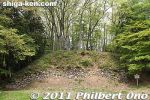
Odani Castle Honmaru stone wall.May 14, 2012
|
|

View from Mt. Odani.May 14, 2012
|
|

Odani CastleMay 14, 2012
|
|
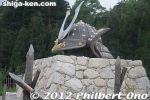
Giant samurai helmet at the Sengoku Guide Station.May 14, 2012
|
|
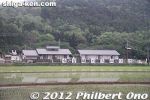
Sengoku Guide Station at the foot of Mt. Odani. This is where you board the bus to go up Odani Castle with a tour guide. This was the Odani–Go no Furusato-kan (小谷・江のふるさと館) pavilion during the Azai Sisters Expo in 2011. Only an expo oMay 14, 2012
|
|
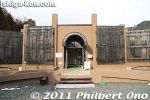
Odani Castle Sengoku Historical Museum. Admission 300 yen (not included in the expo ticket price). Can't take photos inside, but there are two small exhibition rooms explaining about the Azai clan and Odani Castle. No English.May 14, 2012
|
|
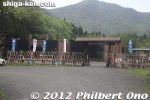
Bus goes to Odani Castle Sengoku Historical Museum (小谷城戦国歴史資) opened in fall 2007. The museum is in the valley adjacent to Mt. Odani.May 14, 2012
|
|
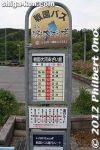
Bus stop at Azai Paviion. Next stop is the Odani area.May 14, 2012
|
|
|
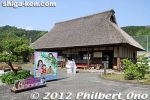
This is the Itohime no Yakata which shows Azai's silk production history. 糸姫の館May 14, 2012
|
|
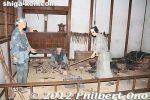
Inside the Blacksmith's Workplace is this exhibit of blacksmiths at work.May 14, 2012
|
|
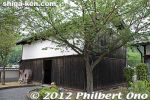
Next to Shichirinkan is this small Blacksmith's Workplace.May 14, 2012
|
|
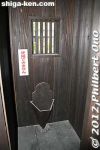
Old toilet inside Shichirinkan, a former blacksmith's house. 七りん館May 14, 2012
|
|
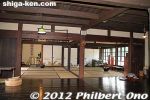
Inside Shichirinkan, a former blacksmith's house. 七りん館May 14, 2012
|
|
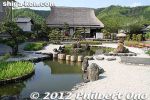
The thatched-roof house is Shichirinkan, a former blacksmith's house. 七りん館May 14, 2012
|
|
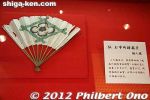
May 14, 2012
|
|
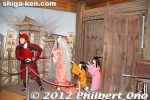
Depicting the escape of Ichi and the three Azai sisters from Odani Castle as it was attacked by Hideyoshi.May 14, 2012
|
|
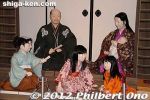
Second floor of Azai Pavilion has mannequins of the Azai family with the three Azai sisters as infants.May 14, 2012
|
|
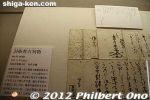
May 14, 2012
|
|

First floor of Azai Pavilion.May 14, 2012
|
|
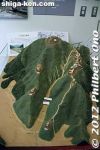
Model of Mt. Odani.May 14, 2012
|
|
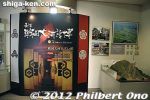
May 14, 2012
|
|

Small theater showing a video of the Battle of Anegawa.May 14, 2012
|
|

Inside the Azai Paviion is this small theater showing a video of the Battle of Anegawa.May 14, 2012
|
|
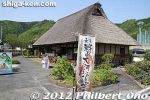
On the right is Itohime no Yakata which shows Azai's silk production history. 糸姫の館May 14, 2012
|
|
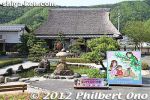
The thatched-roof house in the middle is Shichirinkan, a former blacksmith's house. 七りん館May 14, 2012
|
|
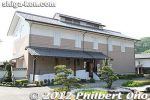
The Azai Paviion is this Folk Studies Museum or Kyodo Gakushu-kan. It centers on the history of Odani Castle and three generations of the Azai Clan. 郷土学習館May 14, 2012
|
|

Map of Azai Folk History Museum which is a complex of small museum buildings including two thatched-roof homes.May 14, 2012
|
|

Entrance to Azai Folk History Museum where one of the buildings is the expo's Azai Paviion. Admission 300 yen.May 14, 2012
|
|
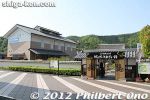
Azai Folk History Museum 浅井歴史民俗資料館(お市の里)May 14, 2012
|
|

Route of the expo shuttle bus from Nagahama Station.May 14, 2012
|
|
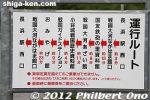
Route of the expo shuttle bus from Nagahama Station. It goes to Kunimoto Gun Museum, Azai Pavilion (Folk Museum), and Odani Castle Guide Station where you can catch the bus to visit Odani Castle.May 14, 2012
|
|
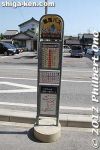
Bus stop in central Nagahama nearest to the Nagahama Pavilion. Bus pass is 500 yen for all day.May 14, 2012
|
|

There are no buses connecting Kinomoto to Nagahama. So take the train. Central Nagahama and the bus stop to visit Azai Folk Museum and Odani Castle.May 14, 2012
|
|
|
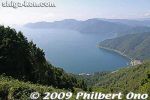
Top of Mt. Shizugatake accessible by chair lift. Great views at the top of Lake Biwa and Lake Yogo.May 14, 2012
|
|

Buses leave Kinomoto Station every 30 min. from 9:45 am to 4:15 pm. It takes less than 10 min. to Mt. Shizugatake.May 14, 2012
|
|

Bus stop at Kinomoto Station to visit Mt. Shizugatake. May 14, 2012
|
|
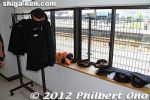
You could even dress up as a train conductor.May 14, 2012
|
|

Inside the old Kinomoto Station. They made it photo op place with a steam locomotive photo in the background.May 14, 2012
|
|
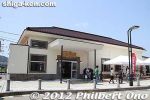
Old Kinomoto Station has been totally renovated.May 14, 2012
|
|
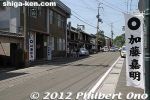
May 14, 2012
|
|
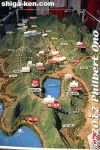
Model of the Battle of Shizugatake site at Mt. Shizugatake and Lake Yogo. It explained how the forces of both sides gathered in this area and fought/retreated.May 14, 2012
|
|
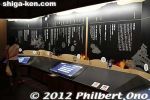
The Kinomoto Pavilion centers on the Battle of Shizugatake in May 1583 between Toyotomi Hideyoshi and Shibata Katsuie who lost.May 14, 2012
|
|

A guide explains about the Battle of Shizugatake inside the Kinomoto Pavilion.May 14, 2012
|
|
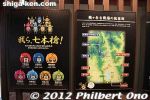
Inside the Kinomoto Pavilion.May 14, 2012
|
|
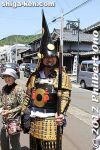
May 14, 2012
|
|
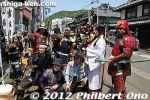
When I got to the Kinomoto Pavilion, this samurai drama group was there posing for photos with tourists.May 14, 2012
|
|

Kinomoto expo pavilion. 戦国大河きのもと館May 14, 2012
|
|
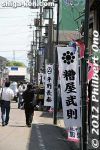
Banners with the names of the seven spearing samurai.May 14, 2012
|
|
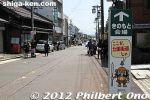
When you reach Hokkoku Kaido road where you see the Jizo-in temple, turn right. May 14, 2012
|
|
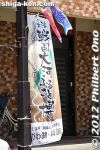
Expo banners also line the way to the Kinomoto pavilion.May 14, 2012
|
|
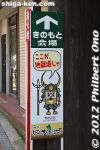
The way to the Kinomoto pavilion is marked with these signboards pointing the way by one of the seven "spearing" samurai famous for fighting in the Battle of Shizugatake.May 14, 2012
|
|
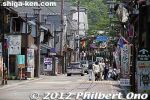
The main pavilion in Kinomoto is a short walk from Kinomoto Station. Jizo-zaka sloping road going to the Hokkoku Kaido road.May 14, 2012
|
|
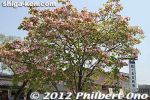
May 14, 2012
|
|

Since the main expo pavilion is in Kinomoto, I started in Kinomoto. The expo focuses on the Battle of Shizugatake and Anegawa River.May 14, 2012
|
|

Mitsunari-kun is the official mascot of the Nagahama Sengoku Taiga Furusato-haku expo. The expo highlights three areas of interest in Nagahama: Odani Castle and Azai, Kinomoto and Mt. Shizugatake, and central Nagahama and Chikubushima island.May 14, 2012
|
|
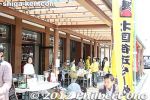
Nagahama Sengoku Taiga Furusato-haku, or Nagahama Warring States Hometown Expo, is a feudal history expo being held from March 24 to Dec. 2, 2012. JR Kinomoto Station on the Hokuriku Line is abuzz during the expo.May 14, 2012
|
|
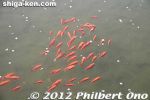
May 14, 2012
|
|
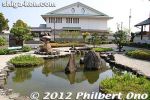
Iris pondMay 14, 2012
|
|

May 14, 2012
|
|
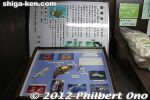
May 14, 2012
|
|
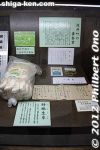
May 14, 2012
|
|
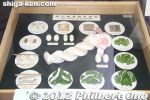
May 14, 2012
|
|
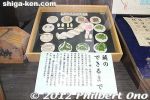
Silk threadMay 14, 2012
|
|
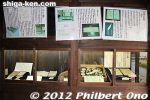
May 14, 2012
|
|
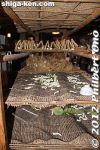
May 14, 2012
|
|
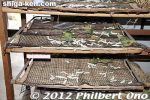
Model of silkworm racks.May 14, 2012
|
|
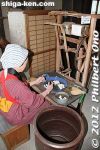
May 14, 2012
|
|
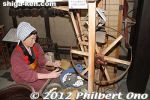
WeaverMay 14, 2012
|
|
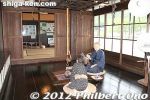
May 14, 2012
|
|
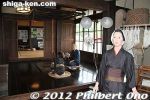
May 14, 2012
|
|
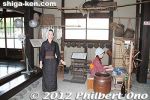
May 14, 2012
|
|
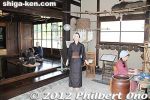
May 14, 2012
|
|
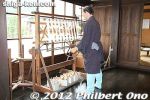
Silk threads.May 14, 2012
|
|

May 14, 2012
|
|
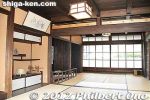
Inside Itohime no Yakata.May 14, 2012
|
|

May 14, 2012
|
|

May 14, 2012
|
|
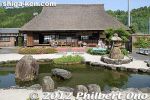
May 14, 2012
|
|
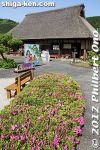
May 14, 2012
|
|
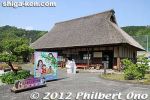
This is Itohime no Yakata which shows Azai's silk production history. 糸姫の館May 14, 2012
|
|

May 14, 2012
|
|

May 14, 2012
|
|

May 14, 2012
|
|
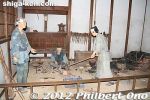
Inside Blacksmith's shop.May 14, 2012
|
|
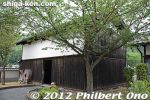
Blacksmith's shopMay 14, 2012
|
|
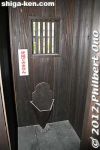
UrinalMay 14, 2012
|
|
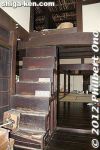
May 14, 2012
|
|
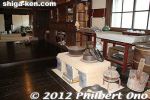
May 14, 2012
|
|
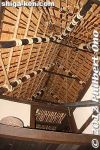
May 14, 2012
|
|
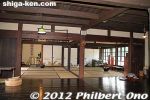
May 14, 2012
|
|
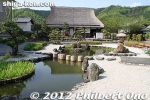
In the middle is a garden with a pond. The thatched-roof house is Shichirinkan, a former blacksmith's house. 七りん館May 14, 2012
|
|
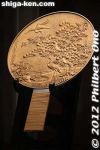
May 14, 2012
|
|
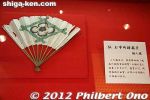
Folding fan supposedly used by Oichi.May 14, 2012
|
|
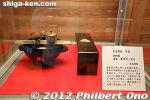
May 14, 2012
|
|
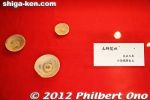
May 14, 2012
|
|
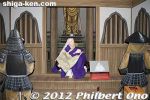
Right after their escape from Odani Castle, Oichi and her three daughters went to a nearby temple in Nagahama whose priest was Nagamasa's older sister. The priest hid the three girls in her robes when Nobunaga's men arrived.It is not known for sure where Oichi and the Azai sisters escaped to. This is only one supposition.May 14, 2012
|
|

About the castle gate.May 14, 2012
|
|

May 14, 2012
|
|
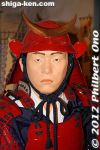
A few years before the attack, Fujikake Nagakatsu, a retainer of Oda Nobunaga, had been assigned to Odani Castle to look after Nobunaga's sister Oichi. 藤懸永勝May 14, 2012
|
|
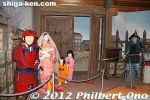
May 14, 2012
|
|

Oichi and daughter Chacha, Hatsu, and Go were led to safety by Fujikake Nagakatsu, a retainer of Oda Nobunaga. He took them to Gifu Castle.May 14, 2012
|
|
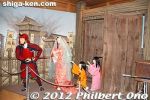
Depiction of Oichi and her three daughters being allowed to escape Odani Castle while it was under attack by Oda Nobunaga in 1573.May 14, 2012
|
|
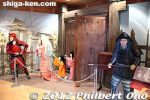
Depiction of Oichi and her daughters being allowed to escape Odani Castle while it was under attack by Oda Nobunaga in 1573.May 14, 2012
|
|

May 14, 2012
|
|
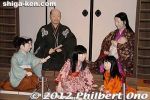
Azai Nagamasa, wife Oichi, son Manpukumaru (left), Chacha in the middle, Hatsu on the right, and Go in Oichi's arms.May 14, 2012
|
|

May 14, 2012
|
|
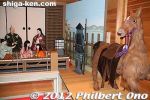
May 14, 2012
|
|
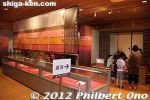
May 14, 2012
|
|
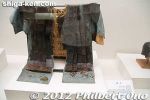
Armor worn around the belly by low-ranking samurai to protect against spears and swords. Supposedly used in the Battle of Anegawa.May 14, 2012
|
|
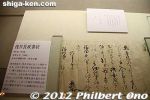
Thank you letter from Azai Nagamasa to a temple for their cooperation in civil construction work.May 14, 2012
|
|
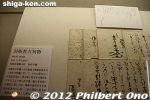
Letter from Ishida Mitsunari.May 14, 2012
|
|
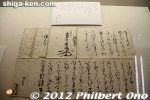
Order written by Toyotomi Hideyoshi to award any Shizugatake residents a reward for killing his enemy.May 14, 2012
|
|

Exhibits about the Battle of Anegawa River.May 14, 2012
|
|
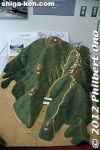
Model of Odani Castle.May 14, 2012
|
|
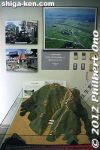
Model of Odani Castle on Mt. Odani.May 14, 2012
|
|
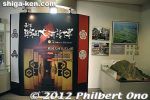
May 14, 2012
|
|

Video screening room explaining the Battle of Anegawa River.May 14, 2012
|
|

Video room explaining the Battle of Anegawa River.May 14, 2012
|
|
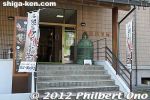
Entrance to Folk Studies Museum.May 14, 2012
|
|
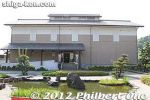
Folk Studies Museum or Kyodo Gakushu-kan. It centers on the history of Odani Castle and three generations of the Azai Clan. 郷土学習館May 14, 2012
|
|
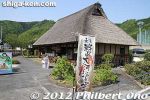
Itohime no Yakata May 14, 2012
|
|
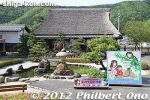
In the rear is the thatch-roofed Shichirinkan 七りん館May 14, 2012
|
|
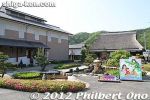
May 14, 2012
|
|
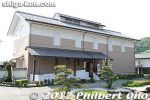
On the left is this modern structure called the Folk Studies Museum or Kyodo Gakushu-kan. It centers on the history of Odani Castle and three generations of the Azai Clan. 郷土学習館May 14, 2012
|
|

About the Battle of Anegawa.May 14, 2012
|
|

Azai Folk History Museum has a few buildings around an iris pond.May 14, 2012
|
|

Entrance to Azai Folk History Museum. May 14, 2012
|
|
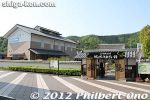
Walk past the library and you come to the gate of the Azai Folk History Museum. Admission 300 yen. Open 9 am to 5 pm, closed Mon. (open if a national holiday) and the day after a national holiday.May 14, 2012
|
|
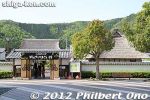
Within Oichi-no-Sato is the Azai Folk History Museum, a small complex of history museums.May 14, 2012
|
|
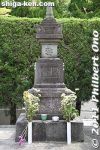
Grave of Azai Hisamasa (1526-1573) at Tokushoji temple in Nagahama, Shiga. He was the second lord of Odani Castle and father of Nagamasa. 浅井久政の墓 長浜市徳勝寺Jun 30, 2011
|
|
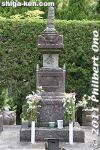
Grave of Azai Sukemasa (1491-1542) at Tokushoji temple in Nagahama, Shiga. He was the first lord of Odani Castle. 浅井亮政の墓 長浜市徳勝寺Jun 30, 2011
|
|
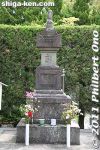
Grave of Azai Nagamasa (1545-1573) at Tokushoji temple in Nagahama, Shiga. He was the third lord of Odani Castle. 浅井長政の墓 長浜市徳勝寺Jun 30, 2011
|
|
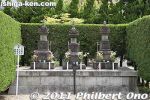
From left to right, the graves of Azai Nagamasa, Sukemasa, and Hisamasa at Tokushoji temple in Nagahama, Shiga. 長浜市徳勝寺Jun 30, 2011
|
|
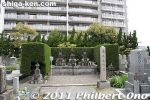
Graves of the Azai clan at Tokushoji temple.Jun 30, 2011
|
|

Walk past the Hondo hall toward the back and there is a cemetery that includes a special block for three graves.Jun 30, 2011
|
|
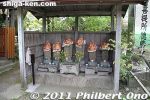
Jizo statues at Tokushoji temple.Jun 30, 2011
|
|

About Tokushoji temple in Japanese.Jun 30, 2011
|
|
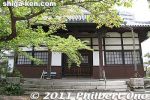
Tokushoji temple Hondo hall. In 1606, Naito Nobunari, lord of Nagahama Castle moved the temple to the present location. 徳勝寺Jun 30, 2011
|
|
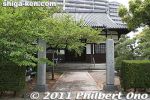
Tokushoji temple Hondo hall. The temple belongs to the Soto Buddhist Sect. After Toyotomi Hideyoshi defeated the Azai in the Battle of Anegawa and Odani Castle fell, he moved to Nagahama Castle and moved the temple to Nagahama Castle in 1595. 徳勝寺Jun 30, 2011
|
|

Azai Sukemasa designated Tokushoji temple as the Azai clan's family temple in 1518 and moved the temple to Shimizu Valley adjacent to Mt. Odani.Jun 30, 2011
|
|
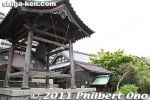
In central Nagahama (walkable from Nagahama Station) is Tokushoji temple (徳勝寺), the location of the graves of Lord Azai Nagamasa and his father Hisamasa and grandfather Sukemasa.Jun 30, 2011
|
|
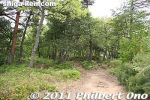
From the Sannomaru was a back road going down to Shimizu valley below where the most people lived.Jun 30, 2011
|
|
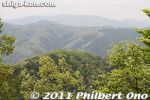
View from Sannomaru.Jun 30, 2011
|
|
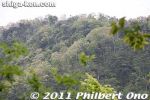
Peak of Mt. OdaniJun 30, 2011
|
|

At the edge of Sannomaru is this trail going down and later up to the peak of My. Odani where the castle continues. However, I stopped here and turned back.Jun 30, 2011
|
|
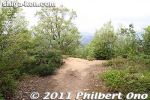
Edge of Sannomaru and trail going beyond.Jun 30, 2011
|
|
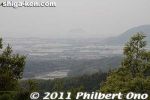
View from Sannomaru.Jun 30, 2011
|
|
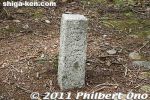
Jun 30, 2011
|
|
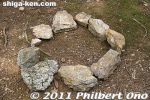
Circle of rocks in Sannomaru. Not sure what it means.Jun 30, 2011
|
|

About the Sannomaru in Japanese. The Sanno Shrine is now Odani Shrine near Mt. Odani.Jun 30, 2011
|
|

Illustration of the Sannomaru. The center section was the highest where there was the Sanno Shrine dedicated to the mountain god. You can see also how the Large Stone Wall looked, part of it remains on the upper right. Jun 30, 2011
|
|

Jun 30, 2011
|
|
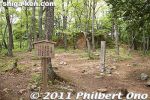
Sannomaru was quite spacious. Jun 30, 2011
|
|

Sannomaru is 400 meters high on the mountain.Jun 30, 2011
|
|
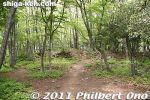
Path to Sannomaru.Jun 30, 2011
|
|
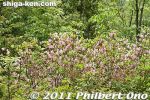
Jun 30, 2011
|
|
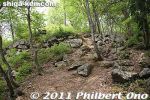
Hill of rocks.Jun 30, 2011
|
|

About the large stone wall in Japanese.Jun 30, 2011
|
|
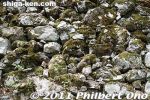
Odani Castle stone wall. Most of the stones were likely carried away to build other castles.Jun 30, 2011
|
|
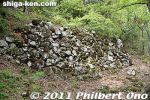
What's left of the large stone wall. It was 5 meters tall and the largest stone wall at Odani Castle, even larger than the Honmaru's stone wall.Jun 30, 2011
|
|
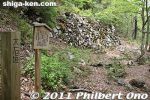
Large Stone Wall at Odani Castle. The original stone wall supported the Sannomaru bailey. 大石垣Jun 30, 2011
|
|
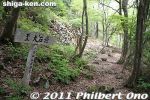
Atop a hill, a sign points to another rare stone wall.Jun 30, 2011
|
|
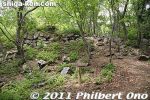
Jun 30, 2011
|
|
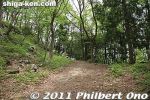
Jun 30, 2011
|
|
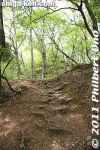
Jun 30, 2011
|
|

Walking further toward Sannomaru.Jun 30, 2011
|
|

About the Komaru bailey in Japanese.Jun 30, 2011
|
|
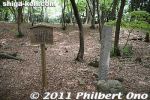
Komaru bailey is said to be where Azai Hisamasa (the second lord of Odani Castle and father of Nagamasa) retired and resided. However, under siege by Toyotomi Hideyoshi, Hisamasa is said to have committed seppuku here on Aug. 27, 1573 at age 49.Jun 30, 2011
|
|
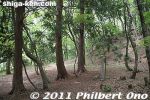
Jun 30, 2011
|
|
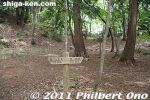
Directional signs.Jun 30, 2011
|
|
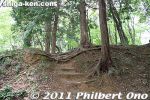
Jun 30, 2011
|
|

Jun 30, 2011
|
|
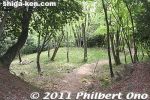
Jun 30, 2011
|
|

About the Kyogoku-maru in Japanese.Jun 30, 2011
|
|

Illustration of Kyogoku-maru which was the second largest bailey in Odani Castle after O-hiroma.Jun 30, 2011
|
|
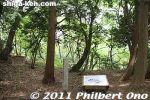
Kyogoku-maru was the site of the Kyogoku clan's residence. This residence fell to Toyotomi Hideyoshi on Aug. 27, 1573 and cut off the connection between Azai Hisamasa staying in Komaru and his son Nagamasa who was in the Honmaru.Jun 30, 2011
|
|

Kyogoku-maruJun 30, 2011
|
|
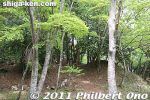
Jun 30, 2011
|
|
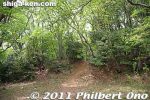
Jun 30, 2011
|
|

Jun 30, 2011
|
|
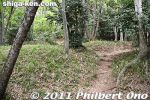
Jun 30, 2011
|
|
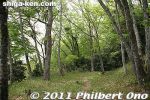
Jun 30, 2011
|
|
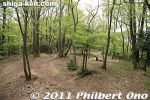
Nakanomaru as seen from Kyogoku-maru.Jun 30, 2011
|
|
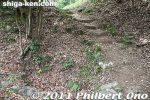
Sword-washing Pond on the left of the steps going to Kyogoku-maru.Jun 30, 2011
|
|
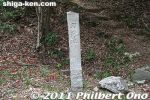
Stone marker for the Sword-washing Pond next to it. This is on the third and highest terrace of Nakanomaru.Jun 30, 2011
|
|
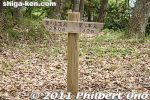
Jun 30, 2011
|
|
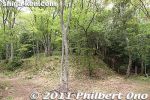
Third terrace of Nakanomaru. You can see the Sword-washing Pond marker on the right.Jun 30, 2011
|
|
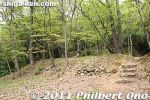
Terrace of Nakanomaru.Jun 30, 2011
|
|

Illustration of Nakanomaru. You can see the three terraces of Nakanomaru. The Honmaru is on the right, separated from Nakanomaru by the large moat.Jun 30, 2011
|
|

About the Nakanomaru bailey in Odani Castle.Jun 30, 2011
|
|
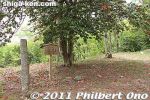
NakanomaruJun 30, 2011
|
|
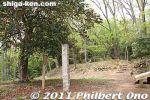
Nakanomaru had three terraces that can still be seen. 中丸Jun 30, 2011
|
|
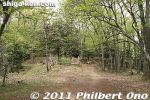
After the Honmaru, the castle spreads out further along the mountain ridge all the way to the peak. This is Nakanomaru, just north of the large moat.Jun 30, 2011
|
|

About the large moat.Jun 30, 2011
|
|
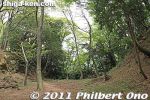
This is the deep moat right beyond the Honmaru which divided the main area of the castle into two sections.Jun 30, 2011
|
|
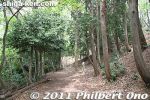
Trail going beyond the Honmaru.Jun 30, 2011
|
|
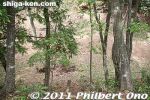
Beyond the top of the Honmaru is a deep ravine. The guided tour ended at the Honmaru, but Odani Castle has other castle keeps beyond, and I left the tour to see them by myself.Jun 30, 2011
|
|

About the Honmaru grounds in Japanese.Jun 30, 2011
|
|
|
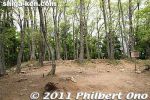
Top of the Honmaru which was the castle's central keep and focal point. Covered with trees now. This is where Azai Nagamasa lived until his defeat and the fall of the castle.Jun 30, 2011
|
|

About the Honmaru.Jun 30, 2011
|
|
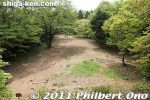
O-hiroma as seen from atop the Honmaru. Lots of rocks, not sure if any of them were foundation stones.Jun 30, 2011
|
|
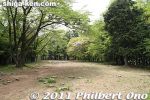
The O-hiroma Hall was said to have had 1,000 tatami mats. As seen from the Honmaru.Jun 30, 2011
|
|

Well in the O-hiroma bailey.Jun 30, 2011
|
|
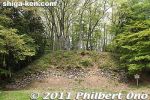
Stone wall of the Honmaru at the far end of the O-hiroma. There are steps on the right to go atop the Honmaru.Jun 30, 2011
|
|

About the O-hiroma hall in Japanese.Jun 30, 2011
|
|

Illustration of O-hiroma hall that was next to the Honmaru seen on the left.Jun 30, 2011
|
|
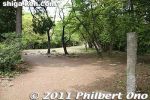
Stone marker for O-hiroma. The enclosure is about 85 meters long and 35 meters wide.Jun 30, 2011
|
|
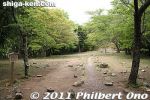
O-hiroma is Odani Castle's largest bailey. The site of a large hall where Azai Nagamasa and Ichi held their wedding. See the illustration. On the far end is the Honmaru.Jun 30, 2011
|
|
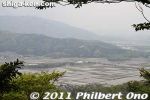
Jun 30, 2011
|
|

About the Kurogane-mon Gate in Japanese.Jun 30, 2011
|
|
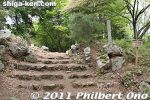
Site of Kurogane-mon Gate that was the entrance to the O-hiroma bailey. They also filmed a scene here for the NHK Taiga Drama, "Go." 黒金門Jun 30, 2011
|
|
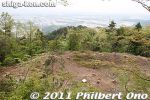
Sakura-no-Baba also overlooks the Ouma-ya Horse Stable.Jun 30, 2011
|
|
| 3007 files on 12 page(s) |
 |
 |
5 |  |
 |
|